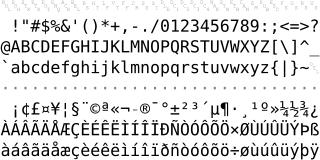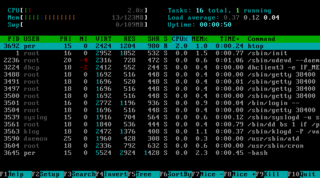Related Research Articles

ISO/IEC 8859-1:1998, Information technology — 8-bit single-byte coded graphic character sets — Part 1: Latin alphabet No. 1, is part of the ISO/IEC 8859 series of ASCII-based standard character encodings, first edition published in 1987. ISO/IEC 8859-1 encodes what it refers to as "Latin alphabet no. 1", consisting of 191 characters from the Latin script. This character-encoding scheme is used throughout the Americas, Western Europe, Oceania, and much of Africa. It is the basis for some popular 8-bit character sets and the first two blocks of characters in Unicode.

Lotus 1-2-3 is a discontinued spreadsheet program from Lotus Software. It was the first killer application of the IBM PC, was hugely popular in the 1980s, and significantly contributed to the success of IBM PC-compatibles in the business market.
UTF-8 is a variable-length character encoding standard used for electronic communication. Defined by the Unicode Standard, the name is derived from UnicodeTransformation Format – 8-bit.

ANSI escape sequences are a standard for in-band signaling to control cursor location, color, font styling, and other options on video text terminals and terminal emulators. Certain sequences of bytes, most starting with an ASCII escape character and a bracket character, are embedded into text. The terminal interprets these sequences as commands, rather than text to display verbatim.
The Multinational Character Set is a character encoding created in 1983 by Digital Equipment Corporation (DEC) for use in the popular VT220 terminal. It was an 8-bit extension of ASCII that added accented characters, currency symbols, and other character glyphs missing from 7-bit ASCII. It is only one of the code pages implemented for the VT220 National Replacement Character Set (NRCS). MCS is registered as IBM code page/CCSID 1100 since 1992. Depending on associated sorting Oracle calls it WE8DEC, N8DEC, DK8DEC, S8DEC, or SF8DEC.
In computer programming, digraphs and trigraphs are sequences of two and three characters, respectively, that appear in source code and, according to a programming language's specification, should be treated as if they were single characters.
ISO/IEC 2022Information technology—Character code structure and extension techniques, is an ISO/IEC standard in the field of character encoding. Originating in 1971, it was most recently revised in 1994.
Extended Unix Code (EUC) is a multibyte character encoding system used primarily for Japanese, Korean, and simplified Chinese.

The HP 200LX Palmtop PC, also known as project Felix, is a personal digital assistant introduced by Hewlett-Packard in August 1994. It was often called a Palmtop PC, and it was notable that it was, with some minor exceptions, a MS-DOS-compatible computer in a palmtop format, complete with a monochrome graphic display, QWERTY keyboard, serial port, and PCMCIA expansion slot.
The currency sign¤ is a character used to denote an unspecified currency. It can be described as a circle the size of a lowercase character with four short radiating arms at 45° (NE), 135° (SE), 225° (SW) and 315° (NW). It is raised slightly above the baseline. The character is sometimes called scarab.
In Unicode, a Private Use Area (PUA) is a range of code points that, by definition, will not be assigned characters by the Unicode Consortium. Three private use areas are defined: one in the Basic Multilingual Plane, and one each in, and nearly covering, planes 15 and 16. The code points in these areas cannot be considered as standardized characters in Unicode itself. They are intentionally left undefined so that third parties may define their own characters without conflicting with Unicode Consortium assignments. Under the Unicode Stability Policy, the Private Use Areas will remain allocated for that purpose in all future Unicode versions.
The C0 and C1 control code or control character sets define control codes for use in text by computer systems that use ASCII and derivatives of ASCII. The codes represent additional information about the text, such as the position of a cursor, an instruction to start a new line, or a message that the text has been received.

Motorola S-record is a file format, created by Motorola in the mid-1970s, that conveys binary information as hex values in ASCII text form. This file format may also be known as SRECORD, SREC, S19, S28, S37. It is commonly used for programming flash memory in microcontrollers, EPROMs, EEPROMs, and other types of programmable logic devices. In a typical application, a compiler or assembler converts a program's source code to machine code and outputs it into a HEX file. The HEX file is then imported by a programmer to "burn" the machine code into non-volatile memory, or is transferred to the target system for loading and execution.

The HP 95LX Palmtop PC, also known as project Jaguar, was Hewlett Packard's first MS-DOS-based pocket computer, or personal digital assistant, introduced in April 1991 in collaboration with Lotus Development Corporation. It can be seen as successor to a series of larger portable PCs like the HP 110 and HP 110 Plus.

Extended ASCII is a repertoire of character encodings that include the original 96 ASCII character set, plus up to 128 additional characters. There is no formal definition of "extended ASCII", and even use of the term is sometimes criticized, because it can be mistakenly interpreted to mean that the American National Standards Institute (ANSI) had updated its ANSI X3.4-1986 standard to include more characters, or that the term identifies a single unambiguous encoding, neither of which is the case.
In computing HP Roman is a family of character sets consisting of HP Roman Extension, HP Roman-8, HP Roman-9 and several variants. Originally introduced by Hewlett-Packard around 1978, revisions and adaptations were published several times up to 1999. The 1985 revisions were later standardized as IBM codepages 1050 and 1051. Supporting many European languages, the character sets were used by various HP workstations, terminals, calculators as well as many printers, also from third-parties.
In computing, a hardware code page (HWCP) refers to a code page supported natively by a hardware device such as a display adapter or printer. The glyphs to present the characters are stored in the alphanumeric character generator's resident read-only memory and are thus not user-changeable. They are available for use by the system without having to load any font definitions into the device first. Startup messages issued by a PC's System BIOS or displayed by an operating system before initializing its own code page switching logic and font management and before switching to graphics mode are displayed in a computer's default hardware code page.
The RPL character set is an 8-bit character set and encoding used by most RPL calculators manufactured by Hewlett-Packard as well as by the HP 82240B thermo printer. It is sometimes referred to simply as "ECMA-94" in documentation, although it is for the most part a superset of ISO/IEC 8859-1 / ECMA-94 in terms of printable characters, and it differs from ISO/IEC 8859-1 by using displayable characters rather than control characters in the 0x80 to 0x9F range of code points.
The Lotus Multi-Byte Character Set (LMBCS) is a proprietary multi-byte character encoding originally conceived in 1988 at Lotus Development Corporation with input from Bob Balaban and others. Created around the same time and addressing some of the same problems, LMBCS could be viewed as parallel development and possible alternative to Unicode. For maximum compatibility, later issues of LMBCS incorporate UTF-16 as a subset.

BraSCII is an encoded repertoire of characters that was used in Brazil. It was used in the 1980s on several printers, in applications like Carta Certa, in video boards and it was the standard character set in the Brazilian line of MSX computers. This code page is known by Star printers as Code page 3847.
References
- ↑ Standard ECMA-94: 8-bit Single-Byte Coded Graphic Character Set (PDF) (1 ed.). European Computer Manufacturers Association (ECMA). March 1985 [1984-12-14]. Archived (PDF) from the original on 2016-12-02. Retrieved 2016-12-01.
Since 1982 the urgency of the need for an 8-bit single-byte coded character set was recognized in ECMA as well as in ANSI/X3L2 and numerous working papers were exchanged between the two groups. In February 1984 ECMA TC1 submitted to ISO/TC97/SC2 a proposal for such a coded character set. At its meeting of April 1984 SC decided to submit to TC97 a proposal for a new item of work for this topic. Technical discussions during and after this meeting led TC1 to adopt the coding scheme proposed by X3L2. Part 1 of Draft International Standard DTS 8859 is based on this joint ANSI/ECMA proposal....Adopted as an ECMA Standard by the General Assembly of Dec. 13–14, 1984.
- ↑ Schemenaur, P. J. (1986-10-27). "Firm to Debut Clone Version of Lotus 1-2-3 - Program Offers 2.0 Compatibility". InfoWorld . Retrieved 2016-11-29.
Twin Release 2 keeps the IBM extended character set of Version 1A, rather than Release 2.0's Lotus International Character Set, which... causes problems with commercial templates designed for Lotus 1-2-3, Release 1A.
- 1 2 Attia, Zayn 'Utbah (2015-03-11). "ASCII graphic characters, range names". Computer Tips. Archived from the original on 2016-11-30. Retrieved 2016-11-29.
Release 1A's capability to use extended graphics characters to dress up a screen was an undocumented feature. These characters allowed you to draw boxes and add special symbols on the screen. With Release 2, Lotus has assigned different meanings to these characters, the Lotus International Character Set, LICS. Any these extended characters must be erased or replaced with regular keyboard characters before the character can appear acceptable on an Release 2 screen. Release 2.01 offers an install option to use extended characters rather than LICS characters.
- 1 2 Cobb, Douglas; Cobb, Steven (1988-10-31). "Spreadsheet clinic: How to adjust SuperCalc's financial functions to analyze annuities due, create flashing screen messages in 1-2-3, and access upper-level ASCII characters in Quattro and 1-2-3". PC Magazine : 411. Archived from the original on 2016-12-02. Retrieved 2016-12-01.
Unlike 1-2-3, Quattro uses the ASCII character set. By default, 1-2-3, Release 2.01, uses the Lotus International Character Set (LICS) — the same character set that Release 2.0 always uses...you can command Release 2.01 to use the ASCII character set, just as Quattro does....load the install program, and select Advanced Options...select TextDisplay...choose Universal Text Display — ASCII-No LICS...Now, when you load 1-2-3 using the modified driver set, the @CHAR function will produce upper-level ASCII characters...(NB. By "Upper-level ASCII", the authors actually meant the 8-bit OEM character set.)
- 1 2 3 "Kapitel 4. Kompatibilität mit anderen 1-2-3 Versionen - Zeichensätze" [Chapter 4. Compatility with other 1-2-3 Versions - Character Sets]. Lotus 1-2-3 Version 3.1 Upgrader's Handbuch[Upgrader's handbook] (in German) (1 ed.). Cambridge, MA, USA: Lotus Development Corporation. 1989. pp. 4-10–4-11. 302173.
- ↑ "HP 95LX". InfoWorld : 72. 1991-12-16. Retrieved 2016-11-26.
- ↑ Matzkin, Jonathan (July 1991). "Hewlett-Packard Co. HP 95LX Palmtop PC". PC Magazine : 216, 220, 222. Retrieved 2016-11-26.
- ↑ Lee, Yvonne (1993-05-03). "HP 100LX rolled out as successor to palmtop". InfoWorld : 27. Retrieved 2016-11-26.
- ↑ Marshall, Patrick (1993-08-23). "Hewlett-Packard makes a good thing better by packing 100LX with features". InfoWorld . Retrieved 2016-11-26.
- ↑ "Questions and Answers about HP Palmtops: Q. What software is built into the 200LX ROM?". The HP Palmtop Paper Online. Archived from the original on 2016-11-27. Retrieved 2016-11-26.
- 1 2 3 Kamenz, Alfred; Vonhoegen, Helmut (1992). Das große Buch zu Lotus 1-2-3 für DOS (in German) (1 ed.). Data Becker. pp. 131–132, 357–358. ISBN 3-89011-375-3.
- ↑ "Appendix F: Lotus International Character Set (LICS)" (PDF). HP 95LX User's Guide (2 ed.). Corvallis, OR, USA: Hewlett-Packard Company, Corvallis Division. June 1991 [March 1991]. pp. 792–799. Archived (PDF) from the original on 2016-11-28. Retrieved 2016-11-27.
- ↑ "Anhang 2. Der Lotus Multibyte Zeichensatz (LMBCS)" [Appendix 2. The Lotus Multibyte Character Set (LMBCS)]. Lotus 1-2-3 Version 3.1 Referenzhandbuch[Lotus 1-2-3 Version 3.1 Reference Manual] (in German) (1 ed.). Cambridge, MA, USA: Lotus Development Corporation. 1989. pp. A2-1–A2-13. 302168. (While for Lotus 1-2-3 Release 3.1+ for DOS, the manual also contains a few notes on LICS.)